News
How Korean food conquered Asia
20 Sep 2021Fuelled by the popularity of Korean pop music and television shows, Korean food is on-trend among Asian consumers, spurring new product development and e-commerce platforms specialised in ‘K-Food’.
According to figures from the Korean Ministry of Agriculture, Food and Rural Affairs (MAFRA), the ‘new southern region’ has become Korea’s number one export destination with $1.56 billion in exports in 2020, an increase of 9% on the previous year. This region is made up of 10 Southeast Asian countries (Brunei, Cambodia, Indonesia, Laos, Malaysia, Myanmar, Philippines, Singapore, Thailand, and Vietnam) and India.

The popularity of Korean food around Asia is so great that it has become a victim of its own success; MAFRA recently warned against a rise in Chinese food products being fraudulently marketed and sold as Korean in overseas markets, such as Southeast Asia. The Ministry has launched measures to combat such counterfeit goods, such as QR codes that consumers can scan to verify if a product is genuinely Korean.
So, what is behind the explosion in popularity of Korean food and does the trend have longevity?
Euromonitor analyst Shreya Sharma attributes the interest in Korean food and culture to the popularity of Korean television and music.
In India, for instance, online streaming service Netflix reported a 307% year-on-year increase of viewership of Korean soap operas, known by fans as K-Drama, and Korean pop music, K-Pop, in 2020. Data from the Ministry of Commerce and Industry in India shows imports of Korean noodles in India grew in volume by 162% in the same year.
“In 2020, COVID-19 led lockdown accelerated the advocacy and acceptance of Korean culture in India,” Sharma wrote in a recent online blog. “Home isolation gave the time and opportunity to the Indian consumers to deep dive into the Korean culture through K-Dramas and K-Pop and experience it through K-food. The rising popularity of K-Food in India presents a unique growth opportunity for Korean food manufacturers, ingredients and condiments manufacturers and the Consumer Foodservice sector in India post-2020.”
According to Sharma, the appeal of Korean food among Indian consumers is not surprising as both cuisines have many common ingredients, such as sesame oil, chilli, pepper, soy, and spices. Euromonitor surveyed Indian K-Drama fans and found that 88% were willing to try Korean food, and 60% had already tasted Korean food.
Thinking beyond kimchi
A number of Korean food brands are taking advantage of the export opportunity with portfolio renovations.
Seoul-headquartered Daesang has a consumer-facing brand, Jongga, which it describes as its fresh food specialty brand that represents “Korean food beyond kimchi” to a global audience and is “leading the new Korean food culture”.
The company has adapted its products to suit local taste preferences and eating occasions in export destinations. Following a campaign to increase seaweed exports to Southeast Asia, Daesang noticed that Indonesians preferred to eat dried salted seaweed as a snack rather than an accompaniment to white rice, as it is typically eaten in Korea.
Daesang therefore teamed up with local Indonesian brand Mamasuka to launch a range of seaweed snacks in Korean flavours such as salted egg and Korean BBQ, developed specifically for the Indonesian market, noted The Korean Economic Daily.
K-Food e-commerce platforms
Many Asian consumers are turning to global e-commerce platforms, such as Amazon and Walmart-owned Flipkart in India, to find Korean products, however there is a growing number of online retailers specialising solely in Korean products. KoriKart is an Indian online distributer and marketplace that promises consumers ‘Korea in a cart’, selling Korean cosmetics, food, kitchenware, electronic gadgets and clothes.
Its food range includes instant and vacuum-packed noodles in typical Korean flavours such as kimchi; traditional fermented chili paste, gochujang; scorched rice; seasoned seaweed; and sweet ginger tea. The distributer, which posts regular updates about Korean culinary culture on its blog, also sells Korean health foods, such as dietary supplements such as red ginseng powder and cissus extract to promote weight loss and reduce inflammation.
Keen to cash in on the K-Food trend, the Korean Ministry of Food, Agriculture and Rural Affairs has said it will create online ‘pavilions’ to sell Korean food and drink, including on private e-commerce platforms such as Shopee, the biggest e-commerce site in Southeast Asia. The Ministry will also increase support for small and medium-sized food exporters to enter online markets, helping them with red tape, logistics, and publicity, it said.
According to Euromonitor’s Sharma, the future for K-Pop, K-Drama and K-Culture looks bright, promising long-term opportunities for Korean food manufacturers and foodservice operators throughout 2021.
“K-noodles manufacturers would also need to think about the competition they would face from established Indian brands such as Maggi, Yippie!, if they expanded to mass consumers,” she said. “As of now, Korean food manufacturers have an opportunity to develop their distribution and expand their market amongst a niche base of consumers who are experimental and willing to pay a premium for noodles. The growth of K-food in India, the entry of Korean brands, and how the local market adapts to this acquired taste remains an interesting space to look out for.”
